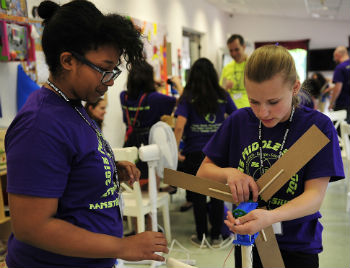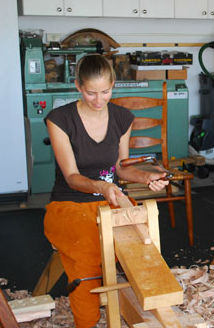Employers and Universities: Work with us?

How to improve problem-solving skills for the workplace
This post features a KEY SKILL: Problem-solving
Problem solving is part of everyday life, and we face problems from the moment we wake up to the moment we go to bed.
Employers rate problem-solving skills highly, so you need to demonstrate that you have them. But if you’ve never had a job, how can you possibly know how to solve problems at work?
In this article, we explore how to improve problem-solving skills for the workplace - while you're still at school!
'How to improve problem-solving solving skills for the workplace - at school'
What is problem solving and why is it important at work?
Problems come in all shapes and sizes, from how to cross the road to how to overcome an obstacle. At school, you’re probably most familiar with problems from maths: 1+x=3, so what is x?
This is an easy one (clue: the answer’s 2), but even so, you have to think about the information you have, what it tells you, and how you can use it to get to the answer. And this is the essence of all problem solving: travelling from A to B using logic to get there.
Before you read any further, take a look at this short video to get an idea of what problem-solving is all about:
At work, you might face all sorts of problems, and here are just a few:
1. Making the best of your time
So you've got your algebra homework due for maths, your composition for music and an essay deadline coming up for English. What do you do?
You prioritise, of course. You look at what’s due in first, how long each piece of work is going to take you, and make a plan to make sure everything gets done on time. Balancing all the projects and tasks you have on the go is something you'll have to do every day in many jobs.

2. Learning and adapting
Remember when you were trying to learn the periodic table and it just wouldn’t sink in? You couldn’t for the life of you remember whether it started with the helium or hydrogen. You realised that you weren’t getting anywhere and that you needed a technique to help you – so you learn the Elements Song!
Well, working out where you’re going wrong and coming up with a strategy to get around it is a great problem-solving skill. If you can demonstrate this ability to an employer, they'll know that they won’t have to sit with you for hours on end explaining the same thing over and over again.
3. Working things out
This is hardcore problem solving – often called critical or analytical thinking – and it’s this kind of thing that employers really love. This is especially true if you’re going into a career where you’ll have to solve problems as part of your day-to-day work, such as a games development, engineering, or medicine.
If you’re a doctor and a patient comes to you with an ongoing headache, they want you to do more than just give some painkillers and send them on their way. You’ll need to find out where the pain is, what kind of pain it is, what other symptoms the patient has, as well as a whole host of other things which will help you work out what is causing the headaches, how urgent it is, and how to treat it.
What school can teach you about problem solving
As we’ve already seen, you solve countless problems every day of your life, nowhere more than at school. You might be surprised to learn that it’s not just subjects like maths, where it’s easy to see that you need to use problem-solving skills in every task. When it comes to learning how to improve problem-solving skills for the workplace, recognising the problems you face in all your school subjects is a great way to start:
Art and design

Tasks like making a chair involve solving a series of problems
For your latest design project, imagine you are going to make a chair for primary school children. The problem is to use the information you have to design a product that’s right for its users. Since you know the chair is for young children, you can find out what measurements match this group, what colours they like and what the safest and most durable materials are.
English, Drama
If you’ve ever discussed a Shakespeare sonnet in class, you’ve worked on a problem. You’ve used what you know about Shakespeare, the different meanings the words have both now and in his time, and how the rhyme and rhythm can affect the meaning. You’ve looked at different layers of meaning and used this to form an overall idea about what the Shakespeare might be saying in his poem.
History
Can you remember looking at different viewpoints (usually called "sources") in class, and thinking about what these tell you about the events they report on? You might also remember thinking about the difference between primary and secondary sources. Well, when you wrote your essay at the end of it all, you were putting together the pieces of a jigsaw to give your point-of-view on something that happened in the past.
PE
PE requires complex problem-solving at an almost subconscious level. When you play football, you work on the overall problem of how to get the ball to your opponents’ goal, while also working on several smaller problems: how you can help make this happen by passing the ball to another player, and how to stop an opposing player getting it off you? And you have to do all this very quickly, while controlling the ball as well.
Techniques you can use to improve your problem solving skills
If you’re still unsure about your problems solving skills, there are plenty of techniques you can use to make them better.
Here are a couple called the IDEAL and SMART techniques. OK, so they might make you cringe, but they can really help get you started when you're stuck on a problem. Sometimes it’s helpful just to remember what you’re trying to achieve before you act, whether at school, work or any other area of life.
Plus they’re really easy to learn. So why not try them out next time you hit a brick wall? It can’t do you any harm!
IDEAL
IDEAL helps you work through the process of solving problems by breaking down what is quite a complex activity into simple steps:
- Identify problem.
- Define goals.
- Explore ways of reaching your goal.
- Act.
- Look and learn.
SMART
SMART can help you figure out what you’re trying to achieve when you come up against a problem. It also makes sure you can see whether you were successful or not:
- Specific: This helps you avoid setting a goal that’s too vague to reach.
- Measurable: This way, you can work out whether you achieved it or not. If we go back to the chair example for art and design, it could be as simple as having created a chair a primary school student can sit on!
- Attainable: You’ve got to be able to do it, otherwise there’s not much point having a goal to start with.
- Relevant: We think that "relevant" is a bit of a rubbish word here, but basically, it means your goal has to matter. In this case, it has to help you overcome the problem.
- Time bound: In the case of your art and design chair, you need to have done it by the deadline, not in three years’ time.
You can also make problem solving easier by doing some really obvious things like:
- Making a to-do list which breaks down all the steps you need to take
- Imagining what your hero would do (this won’t work if your hero is Homer Simpson)
- Listing things that could go wrong
Now you know how to improve your problem-solving skills for the workplace - before you've even left school! Find out about more transferable skills you'll need at work.
Related posts
How to improve your lateral thinking skills for work
6 ways to improve your time management skills
Image credits
STEM event via Wikimedia Commons
Chair via Russ Filbeck
